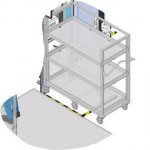theseeker2
New User
- Location
- North Reading, MA, USA
NEC 2014 Article 110.26(B) Clear Spaces. Working space required by this section shall not be used for storage. When normally enclosed live parts are exposed for inspection or servicing, the working space, if in a passageway or general open space, shall be suitably guarded.
Mike Holt?s Illustrated Guide to Essential Rules of the National Electrical Code, Based on the 2011 NEC
INTRODUCTION TO ARTICLE 110?REQUIREMENTS FOR ELECTRICAL INSTALLATIONS
Page 18 reads:
(B) Clear Working Space. The working space required by this section must be clear at all times. Therefore, this space isn?t permit*ted for storage. When normally enclosed live parts are exposed for inspection or servicing, the working space, if in a passageway or gen*eral open space, must be suitably guarded.
I am seeking guidance on the acceptability of temporarily placing a rolling cart within the defined working space of an electrical enclosure (see picture attached). For frame of reference, the electrical enclosure is mounted to the left of the cart and the work space is defined by 5S tape on the floor. The cart would only be rolled to this position intermittently during working hours as needed. When the cart is present an associate standing on the gray mat would be removing objects from the cart and then the cart would be removed (returned to its storage area). When this area is not in use (i.e. after hours, if the work area is unmanned, or if the work area is shut down for maintenance) there would be no cart in this position (i.e. the cart is not stored here). Based on the language in the NEC this appears to be acceptable as the space is not used for storage but based on guidance provided in "Introduction to Article 110" this space is to be clear at all times so this would not be allowed. The application is in Florida so I have a particular interest in how a Florida AHJ would interpret this requirement but would like to understand what is normally accepted. I don't want to approve a workspace layout that could result in a violation but I also don't want to constrain the workspace layout and force a layout redesign if this is acceptable.
Mike Holt?s Illustrated Guide to Essential Rules of the National Electrical Code, Based on the 2011 NEC
INTRODUCTION TO ARTICLE 110?REQUIREMENTS FOR ELECTRICAL INSTALLATIONS
Page 18 reads:
(B) Clear Working Space. The working space required by this section must be clear at all times. Therefore, this space isn?t permit*ted for storage. When normally enclosed live parts are exposed for inspection or servicing, the working space, if in a passageway or gen*eral open space, must be suitably guarded.
I am seeking guidance on the acceptability of temporarily placing a rolling cart within the defined working space of an electrical enclosure (see picture attached). For frame of reference, the electrical enclosure is mounted to the left of the cart and the work space is defined by 5S tape on the floor. The cart would only be rolled to this position intermittently during working hours as needed. When the cart is present an associate standing on the gray mat would be removing objects from the cart and then the cart would be removed (returned to its storage area). When this area is not in use (i.e. after hours, if the work area is unmanned, or if the work area is shut down for maintenance) there would be no cart in this position (i.e. the cart is not stored here). Based on the language in the NEC this appears to be acceptable as the space is not used for storage but based on guidance provided in "Introduction to Article 110" this space is to be clear at all times so this would not be allowed. The application is in Florida so I have a particular interest in how a Florida AHJ would interpret this requirement but would like to understand what is normally accepted. I don't want to approve a workspace layout that could result in a violation but I also don't want to constrain the workspace layout and force a layout redesign if this is acceptable.


